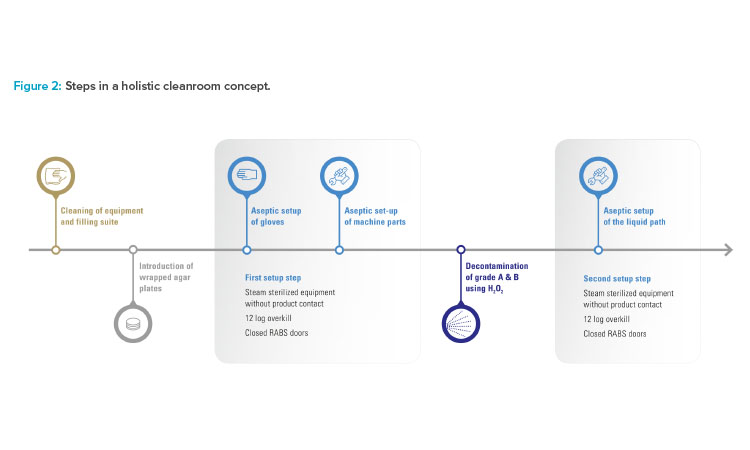A Holistic Cleanroom Concept: Higher Quality & Greater Flexibility

As the pharmaceutical industry balances demands for small-batch and blockbuster products and encounters new regulations, there is a need for efficient and safe production technologies that can meet stringent quality and safety requirements for the aseptic filling of drugs. Looking forward, manufacturers should anticipate future format, packaging, and filling needs, and seek technologies with sufficient built-in versatility. This article explores a promising holistic cleanroom concept for high-quality aseptic processing of drugs.
Aseptic fill-and-finish processing faces special challenges. On the one hand, demand is increasing for small-batch products to treat rare diseases; on the other hand, blockbuster drugs require large batch sizes. To meet divergent product requirements, pharmaceutical companies need flexible manufacturing systems that enable individual line setup for product changeovers.
Additionally, new and revised guidelines updating global regulatory requirements for process safety are expected in the near future. For example, Annex 1 of the EU GMP Guide “Manufacture of Sterile Medicinal Products”—which is considered the most important European regulatory standard for the manufacturing of sterile pharmaceutical products—is under review and being updated. In its current draft version, Annex 1 states that the expected result of microbiological findings within isolators and restricted access barrier systems (RABSs) is 0 CFU recovered, and “all critical surfaces that come into contact with sterile materials should be sterile.”1 There is also a trend in visual inspection to increase requirements regarding detection of particles.2
Conventional Technologies
To date, two technologies for high-quality aseptic processing of drugs have stood out: isolators and restricted access barrier systems. It is important to differentiate between these systems because they offer different types of product protection.
Isolators are completely sealed units, entirely “isolated” from the outside environment. They undergo extensive decontamination that results in constraint levels of adaptability and efficiency.
Restricted access barrier systems technology involves barrier and dynamic airflow separation between the environment and the drug product. Compared with isolators, restricted access barrier systems offer advantages of faster setup, efficient product changeover, and variability. As such, restricted access barrier systems are appropriate for manufacturing operations with several products and short downtimes.
A New Alternative
The starting point for the new technology described in this article was a passive open restricted access barrier systems with closed doors that provides a high level of aseptic control. Thus, the barrier surrounding a grade A clean area is open at the top and the bottom toward a grade B area and is supplied with laminar air from the ceiling of the cleanroom. The barrier can be opened for installation of huge format parts at the beginning of setup. During filling, interventions are only allowed through built-in gloves. Any opening during filling will result in immediate termination of the batch and the discarding of all open units within the barrier.
To improve the already high level of aseptic control, Vetter decided not to convert the existing restricted access barrier systems lines in isolator lines. Instead, the benefits of both conventional solutions were taken to create an alternative, Vetter Cleanroom Technology (V-CRT). Based on a passive open restricted access barrier systems, automated hydrogen peroxide (H₂O₂) decontamination, already well established within isolator technology, plays the most important role in this concept. Being a holistic concept, the technology is not limited to decontamination and its directly linked systems. It also includes setup and filling, and monitoring as well as analytics (Figure 1).
Decontamination
Decontamination is the core element of the holistic cleanroom concept. With automated H₂O₂ decontamination, unwieldy processes such as formaldehyde fumigation are replaced and sources of error in manual decontamination are minimized. Automated H₂O₂ decontamination also provides greater protection from microbiological contamination than wipe-and-spray disinfection. H₂O₂ is an effective decontaminant because it removes critical micro-organisms in grade A areas. In addition, it is practically residue-free because the solution quickly breaks down into water and oxygen.
- 1European Commission. “Targeted Stakeholders Consultation on the Revision of Annex 1, on Manufacturing of Sterile Medicinal Products, of the EudraLex volume 4: Consultation Document.” Accessed 22 October 2019. https://ec.europa.eu/health/sites/health/files/files/gmp/2017_12_pc_annex1_consultation_document.pdf
- 2European Pharmacopoeia. “New Chapter on Visual Inspection for Visible Particles.” Accessed 4 November 2019. https://www.gmp-compliance.org/gmp-news/european-pharmacopoeia-new-chapter-on-visual-inspection-for-visible-particles

A system of stainless steel pipes built into the cleanroom walls and ceiling aerosolizes the H₂O₂ solution into class ISO 5 and 7 cleanrooms through dual-substance jets inside and outside of the barrier. To enable tightness during decontamination, the cleanroom is sealed gas-tight using inflatable door gaskets.
After the cleanroom is sealed, H₂O₂ decontamination can begin. Thanks to the permanently installed nozzles, decontamination of the entire clean-room can work automatically and autonomously. For aerosolization of H₂O₂, the HVAC system is switched off and reactivated after the prescribed reaction time; laminar airflow flushes the entire cleanroom. Implemented catalysts enable rapid H₂O₂ degradation, and a HEPA filter prevents particles from entering the room.
After start of the entire decontamination cycle, the cleanroom area of 144 m3 is ready for use in less than 2.5 hours.
Setup and Filling
Before the automated H₂O₂ decontamination can begin, the cleanroom is carefully prepared and machine surfaces are wiped clean. With the holistic cleanroom concept, manual cleaning prior to H₂O₂ decontamination can be optimized. Manual cleaning is reduced to a minimum, positively influencing downtimes and overall equipment effectiveness (OEE) times.
In the meantime, offline cleaning and steam sterilization of machine parts are performed (Figure 2). When isolator technology is used, gas-tight wrapped agar plates are brought into the barrier after cleaning of the filling suite. Therefore, when the holistic cleanroom concept is applied, storage holders in the barrier are implemented to avoid later transport from grade B to grade A. The concept also adopts Vetter’s restricted access barrier systems process: First, barrier doors are closed. Next, equipment parts that are not product-touching and cannot be transported in a sterile box are installed within the barrier. Therefore, defined barrier doors are allowed to be opened. Gloves are then installed, and the remaining equipment parts are brought into the barrier using sterile boxes. Before any equipment parts are brought into the cleanroom, they are steam-sterilized in an autoclave. The preparation of the manufacturing line behind closed barriers in an aseptic environment further enhances the degree of purity achieved through the system. As a last part of the initial setup step, glove spreaders are installed. Then, the decontamination cycle can begin.

To prevent H₂O₂ uptake of the equipment in contact with the product (liquid path), as a final process step of installation, the second aseptic setup is performed after the decontamination cycle is completed (Figure 2). Installation starts after an H₂O₂ concentration of less than or equal to 0.5 parts per million (ppm) is reached.
Monitoring and Analytics
In addition to monitoring and analytics done as a part of the aseptic filling process, a holistic cleanroom concept requires specific methods to help make certain both products and employees are fully protected from H₂O₂. Thus, the sensors inside and outside the barrier track several variables. H₂O₂ decay is measured within the cleanroom in grade B areas by means of two Polytron sensors within the parts per million levels, and in grade A areas by means of a Picarro sensor down to the parts per billion levels. A flow meter continuously measures the airflow out of the barrier area into the ambient cleanroom air to allow for overflow from environment A to environment B. Product impact can be assessed by H₂O₂ analysis for aqueous solutions. H₂O₂ concentrations in water for injection (WFI) or other product solutions can be verified in the lab.
Ready for Tomorrow’s Challenges
The holistic cleanroom concept is associated with high reliability and reproducibility. Another significant advantage is speed. Depending on the size of the cleanroom, the entire decontamination cycle starting with conditioning of the cleanroom and followed by decontamination (aerosolization), expo-sure, and aeration can be completed in less than 2.5 hours. Appropriate catalysts and a highly effective ventilation system enhance H₂O₂ degradation and lead to short decontamination cycles. Preparation for production and aseptic setup of the cleanroom can begin immediately. Shorter downtimes streamline processes and improve equipment effectiveness.
Vetter Cleanroom Technology optimizes existing production processes by making them more versatile and efficient. Furthermore, it mitigates the risk of microbe carryover from grade B to grade A areas, while still enabling rapid changeover. The contamination recovery rate for cleanrooms operated by Vetter Cleanroom Technology is notable. Since Vetter Cleanroom Technology was commissioned in early 2017, no germs have been detected in grade A environments, which fully meets the requirements in the current An-nex 1 draft.1
The holistic cleanroom concept can be used for new cleanrooms and machinery. The methodology can also be applied to traditional restricted access barrier systems clean-rooms to improve microbial decontamination and cleanroom control. Pharmaceutical and biotech companies can clearly benefit from such technologies.


